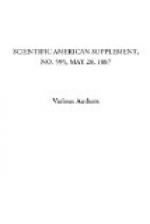Some seem to imagine, without thinking, that the elasticity of the air can add additional energy. This is perfectly erroneous; for elasticity is a mere property, which permits a body to be compressed on the application of a force, and to be dilated by the exercise of the force stored up in it by the compression. No property of the air can impart any energy. If the momentum of a molecule or a series of molecules extending in all directions for a mile is to be overcome so as to control the character of the movements of the molecules, then sufficient external energy must be applied to accomplish the task: and when we think that one cubic inch of air contains 3,505,519,800,000,000,000 molecules, to say nothing about the number in a cubic mile, which a locust can transmit sound through, we are naturally compelled to stop and think whether the vibrations of supposed molecules have anything or can have anything to do with the transference of sound through the air.
If control was only had of the distance the vibrating molecule travels from its start to the end of its journey, then only the intensity of the sound would be under subjection; but if at every infinitesimal instant control was had of its amplitude of swing, then the character, timbre, or quality of the sound is under subjection. It is evident, then, that the blows normally given by one molecule to another in their supposed constant bombardment must not be sufficient to alter the character of vibration a molecule set in oscillation by a sounding body must maintain, to preserve the timbre or quality of the sound in process of transmission; for if any such alteration should take place, then, naturally, while the pitch, and perhaps intensity, might be transmitted, the quality of the sound would be destroyed.




